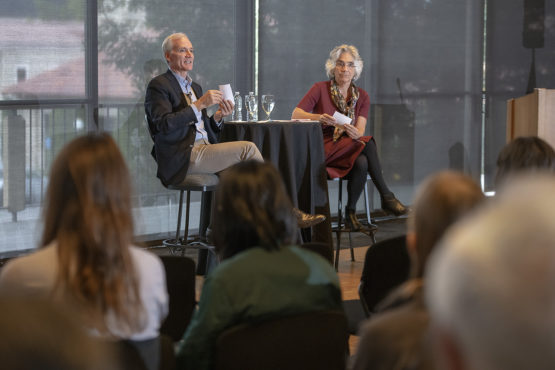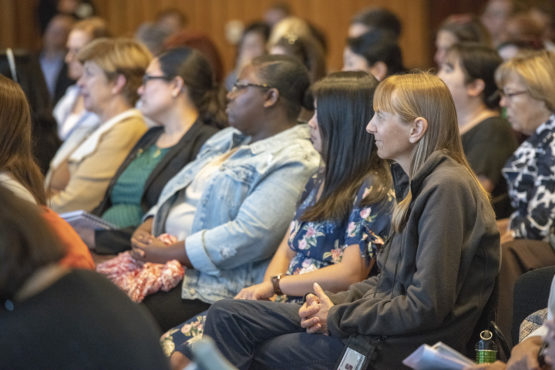President and provost host conversation with the campus community
President Marc Tessier-Lavigne and Provost Persis Drell answered questions about the long-range vision and other campus issues.
President Marc Tessier-Lavigne and Provost Persis Drell discussed Stanford’s long-range vision and addressed a variety of university issues – from changes in student affairs to affordability issues and upcoming campus climate surveys – during a community meeting Monday afternoon.
An audience of more than 100 staff, faculty, students and post-doctoral scholars attended the hour-long meeting in Tresidder Union.
Long-range vision

President Marc Tessier-Lavigne and Provost Persis Drell answer written questions submitted by the audience of faculty, staff and students. (Image credit: L.A. Cicero)
Tessier-Lavigne began the meeting by updating the community on what had transpired with Stanford’s long-range planning process since the rollout last May of Our Vision: Navigating a Dynamic Future. Based on months of community input, discussion and synthesis, the vision set priorities and outlined initiatives in the areas of values, research, education and community.
“This academic year, we are going from a high-level vision, which declared our priorities, and turning it into an actionable plan,” he said.
A structure was put in place to help develop plans for how Stanford would implement each of the 19 initiatives. Design teams and task forces, led by faculty co-chairs, are in the final stages of being established. Tessier-Lavigne noted that the teams will vary in size, approach and level of participation depending on the objective of each initiative.
He said that most of the teams will begin work this fall, although some started earlier – for instance, ResX, which is looking at the undergraduate residential experience. Among the duties of the design teams will be to complete a baseline review, establish priorities, recommend an implementation plan and set criteria to measure progress and success. The names of co-chairs and more details will be announced later this week.
The goal is to present a final initiative strategy to the Board of Trustees in April and then to the university community in May 2019, he said.
In response to questions about the overlap of some of the initiatives and general oversight of the project, Tessier-Lavigne said, “There is some overlap and, in some cases, it’s quite deliberate because we felt there was value in separating out some of the issues.” He added that all co-chairs would meet regularly and that Megan Pierson, the president’s chief of staff, would continue to provide oversight for the long-range vision.
Campus issues
In her remarks, Provost Drell addressed a number of campus issues, including new developments in student affairs. Emphasizing that the goal in student affairs is to help all students thrive during their time at Stanford, she said that the focus is shifting to areas that students have expressed as most essential: mental health and well-being; equity and inclusion; integrative learning; and community and belonging. A new organizational structure reflecting these priority areas has been put in place by Vice Provost for Student Affairs Susie Brubaker-Cole.

The conversation with the president and provost drew an audience that nearly filled the Oak Room in Tresidder Union. (Image credit: L.A. Cicero)
“To address these priorities, it means that we have to change, in ways both large and small,” Drell said. “I’m doing all I can to support student affairs, which has never been more important than it is now.”
Drell concluded her formal remarks by encouraging attendees to participate in surveys that will be administered separately to staff, faculty and students during the 2018-19 academic year. A staff engagement survey will be administered this fall and a faculty survey in the winter. Students will be encouraged to participate in the spring in a campus climate survey being administered by the Association of American Universities (AAU).
In response to a question about contemplative and supportive spaces on campus, Drell said that a need to redevelop the center of campus became apparent during the long-range planning process. She specifically pointed to Tresidder Union and White Plaza as areas in need of reexamination and redesign over the longer term.
Another set of questions revolved around the lack of civility in public discourse and the effect of recent national events on members of the campus population. Drell acknowledged that this was a difficult time for many people in light of the massive media coverage of the Senate confirmation hearings. She encouraged students, staff and faculty to make use of the resources available on campus, including emotional support resources and programs and services addressing the issue of sexual violence.
Tessier-Lavigne referred to a piece about advancing both free speech and inclusion that he and Drell co-authored last year on the Notes from the Quad blog. He emphasized that having a diversity of perspectives on campus continues to be essential to Stanford’s research and educational missions.
“The way you reconcile free expression and inclusion is by encouraging an atmosphere of respectful dialogue among diverse perspectives,” he said. “As we have previously said, you can’t mandate respect. What you can do is model it. You can disagree without being disagreeable.”
Vice President for Human Resources Elizabeth Zacharias responded to questions about affordable housing for staff. As chair of the Affordability Task Force, she said the group was focusing on four aspects of the issue: housing, child care, transportation and benefits. She noted that it was too early in the process to suggest solutions and that any initiatives proposed by the task force would vary depending on the population – staff, faculty, graduate students and post-doctoral scholars.
Other topics the president and the provost discussed during the question-and-answer session included initiatives looking at the acceleration of research interventions, campus sustainability efforts, clarification on dining hall policies and staff development opportunities.
